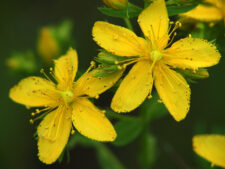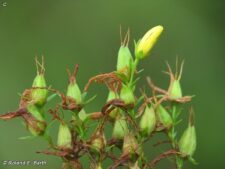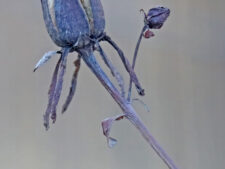
COMMON ST. JOHN’S-WORT
Hypericum perforatum
ST. JOHN'S-WORT FAMILY (Hypericaceae)
 Identification
Identification
- Flowering time - June, July, August
- Uncommon in sunny, disturbed areas at FF and NW
- 5 showy yellow petals with long bright yellow stamens
- Fine teeth and black dots along one side of the petal
- Leaves with translucent and/or black spots
This naturalized perennial was introduced from Europe. The stout stems, up to 2 feet tall, have many opposite branches (A). The small elliptic leaves are opposite on the stems. A closer look at the leaves reveals many translucent and a lesser number of black dots (D). The flowers are in clusters at the ends of branches, each flower about 1 inch across. The 5 bright yellow petals, finely toothed on one side only, have marginal black dots (B,C). Each flower has three bundles (fascicles) of yellow stamens. Flowers are replaced by clusters of small, conical pods (E). See also Greater St. John’s-Wort (Hypericum pyramidatum), which has much larger flowers and seed heads.
Found in sunny areas along roadsides and disturbed ground, flowering from June through August. It is uncommon at both Fontenelle Forest and Neale Woods. Most recent sightings at Fontenelle Forest have been on the floodplain. At Neale Woods it is most commonly seen in the prairie restorations.
This plant can be quite aggressive and has become a troublesome weed in some parts of the United States.
The translucent and black dots on the leaves are glandular structures. The oil from these glands contains active chemical compounds which have been used in folk medicine for a wide variety of ailments since at least the first century. The species name, perforatum, was prompted by these same translucent dots on the leaves, which look like small holes when held up to the light.
The name St. Johnswort appears related to its time of flowering around the 24th of June which was observed as St. John’s Feast Day. Magical powers were attributed to it and it was often hung over doorways and stalls for protection from evil spirits and disease. Its reputation is reflected in alternate common names like Touch-And-Heal and Devil’s Scourge. A less complimentary common name is Goatweed.
The content of NatureSearch is provided by dedicated volunteer Naturalists of Fontenelle Forest who strive to provide the most accurate information available. Contributors of the images retain their copyrights. The point of contact for this page is: Roland Barth.





